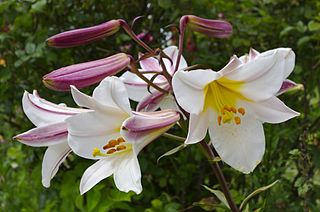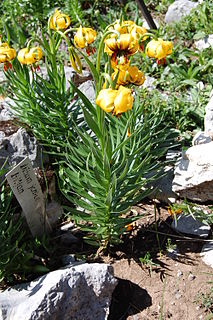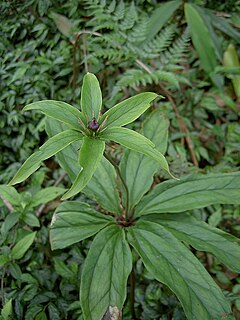
Lilium lancifolium is an Asian species of lily, native to China, Japan, Korea, and the Russian Far East. It is widely planted as an ornamental because of its showy orange-and-black flowers, and sporadically occurs as a garden escapee in North America, particularly the eastern United States including New England, and has made incursions into some southern states such as Georgia.

Lilium is a genus of herbaceous flowering plants growing from bulbs, all with large prominent flowers. They are the true lilies. Lilies are a group of flowering plants which are important in culture and literature in much of the world. Most species are native to the northern hemisphere and their range is temperate climates and extends into the subtropics. Many other plants have "lily" in their common names, but do not belong to the same genus and are therefore not true lilies.

Lilium bulbiferum, common names orange lily, fire lily,Jimmy's Bane and tiger lily, is a herbaceous European lily with underground bulbs, belonging to the Liliaceae.

Lilium regale, called the regal lily, royal lily, king's lily, or, in New Zealand, the Christmas lily, is a species of flowering plant in the lily family Liliaceae, with trumpet-shaped flowers. It is native to the western part of Sichuan Province in southwestern China, and cultivated elsewhere as an ornamental. It was introduced to England in 1903 by Ernest Henry Wilson.

Lilium ledebourii is a rare Asian species of plants in the lily family. It was named for German-Estonian botanist Carl Friedrich von Ledebour (1786-1851). Its native range is the Talish region of Azerbaijan, and Damasch in the Amarlu region of Iran.

Hemerocallis fulva, the orange day-lily, tawny daylily, corn lily, tiger daylily, fulvous daylily, ditch lily or Fourth of July lily, is a species of daylily native to Asia. It is very widely grown as an ornamental plant in temperate climates for its showy flowers and ease of cultivation. It is not a true lily in the genus Lilium, but gets its name from the superficial similarity of its flowers to Lilium and from the fact that each flower lasts only one day.

Lilium columbianum is a lily native to western North America. It is also known as the Columbia lily, Columbia tiger lily, or simply tiger lily.

Lilium bosniacum is a lily native to Bosnia and Herzegovina. It's also known as Zlatni Ljiljan and Bosanski Ljiljan.

Lilium maculatum is a plant in the lily family native to Japan.

Lilium bolanderi is a rare North American species of plants in the lily family, known by the common name Bolander's lily. It is native to northwestern California and southwestern Oregon.

Lilium maritimum is a species of lily known by the common name coast lily. It is endemic to California, where it is known only from the coastline north of San Francisco. It formerly occurred south of San Francisco, but these occurrences have all been extirpated. The species is now restricted to the North Coast from Marin County to Del Norte County, and is most common in Mendocino County. It grows in the California coastal prairie habitat, coniferous forests, and bogs amongst Drosera species.

Lilium occidentale is a rare North American species of lily known by the common name western lily. Its species name 'Occidentale' means 'westernmost' and refers to its location along the West Coast. It is native to northwestern California and southwestern Oregon. It grows in coastal prairie habitat, swamps and stagnant bogs with Drosera species, bluffs and sandy cliffs, and seaside spruce forests. This rare wildflower is limited in distribution and directly endangered by a number of environmental factors. It is a federally listed endangered species and it is listed as endangered by the states of California and Oregon.

Lilium parryi, common name lemon lily, is a rare species of lily.

Lilium pumilum is an Asian species of bulbous plants native to Mongolia, Siberia, the Russian Far East, Korea and northern China.

Lilium monadelphum is a bulbous plant native to Crimea and to North and South Caucasus.

Lilium pensylvanicum is an Asian plant species of the family Liliaceae. Sometimes called the Siberian lily, it is native to a cold climate and needs frost in the winter. It is found in the wild form in Siberia, the Russian Far East, Mongolia, northeast China, Korea and Hokkaidō.

Lilium iridollae is a species of Lilium or lily. It is a perennial forb. This species is considered one of five known Lilium species native to specific sites in the United States' southeast region. In 1940, this species was discovered by Mary Henry in its habitat. She named the lily in reference to a "pot of gold at the end of the rainbow".

Paris polyphylla is an Asian species of flowering plant native to China, Taiwan, the Indian Subcontinent, and Indochina. It produces spider-like flowers that throw out long, thread-like, yellowish green petals throughout most of the warm summer months and into the autumn. In the fall, the flowers are followed by small, scarlet berries. It is a perennial, which slowly spreads, is fully hardy in Britain, and survives in leafy, moist soil in either complete or partial shade.
Lilium sherriffiae is a species of Lilium native to Bhutan and Nepal in southeastern Asia.

Lilium polyphyllum is a species of lily endemic to montane environments in central Asia.



















